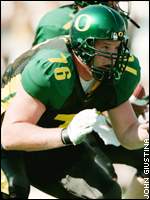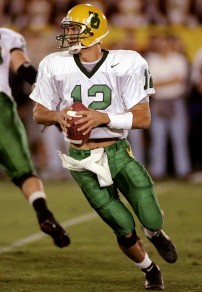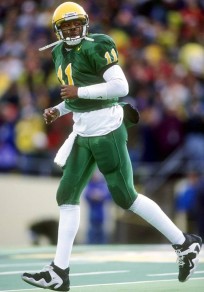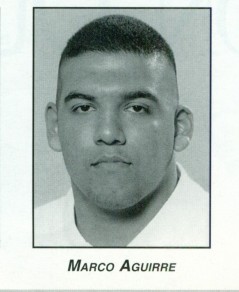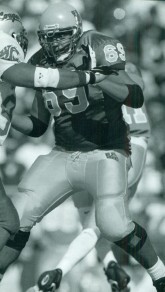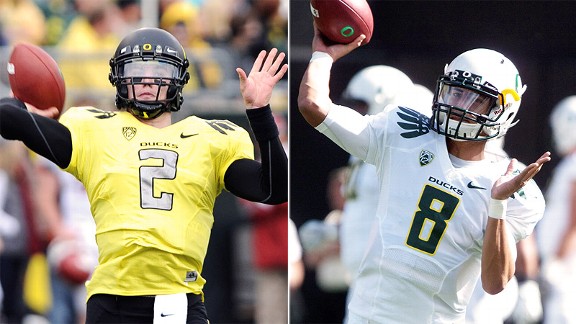
This year all the talk in camp is who will be quarterback-Bennett or Mariota. 15 years ago, a nearly identical QB battle played out in camp.
As Oregon prepares for the 2012 football season, one question garners more attention than all others: who plays quarterback? It’s not the first time Oregon went into the season with a sharply divided fan base, arguing over which one was better. In the past Oregon has implemented multiple quarterback rotations, with varied results.
One of those times when Oregon coaches were faced with the dilemma of whom to start had eerily similar circumstances to today; the 1997 battle between veteran with limited playing time Jason Maas, and talented newcomer Akili Smith.
Fifteen years ago, Oregon was in the midst of 1997’s fall camp. Following two very successful nine-win years (1994, 1995), Oregon had struggled through 1996 to barely pull off a winning season, left out of a bowl game due to a controversial selection of California instead (the Bears had an equal record with Oregon and had lost to the Ducks.)
While the 1996 season had been ravaged by injuries leading to a disappointing overall record, it ended on a high mark, winning three in a row, giving the returning team cause for enthusiasm heading into 1997. Many of the 1994 Rose Bowl stalwarts were now seniors with great leadership abilities, and the incoming 1997 recruiting class was considered the greatest in Oregon history to that point, the team had all the pieces to begin a climb towards greatness for Oregon football.
Gone were defensive veterans Kenny Wheaton, Reggie Jordan, Derrick Barnes, Mark Schmidt, and Bryant Jackson, and on offense there were concerns as well. At quarterback, veteran Tony Graziani had graduated, as well as experienced backup Ryan Perry-Smith. Only Junior Jason Maas had any game experience.
Returning though was running back Saladin McCullough, who had set the single-season touchdown record at Oregon the year prior, and All-Pac-10 selection WR Damon Griffin, who was thought to be able to contribute, but a thumb injury would force a medical redshirt leaving him sidelined all season. Even without Griffin’s availability, the receiving corps was stacked; with Patrick Johnson, JC-transfer Donald Haynes, Tony Hartley, and tight ends Jed Weaver and Blake Spence–both providing NFL-caliber talent.
Beyond the receivers and backs though, the biggest issue facing the Ducks was depth. The roster lacked much game experience, questionmarks abound. A new identity was required, and for this Oregon looked to the junior college ranks. Not ready to hand the team entirely over to Maas, in stepped junior-college transfer quarterback Akili Smith, with the promise of being able to compete openly for the starting job despite Maas being the perceived heir-apparent having played well in his limited appearances.
It was a situation similar to the one currently facing Oregon: a returning QB with SOME game experience who seemed all but assured the job, until the new guy arrived with loads of potential, splitting perceptions of whom should start.
The quarterback wasn’t the only issue facing the team, along the offensive line Oregon faced the daunting task of replacing 4 of 5 starters. Gone were five stalwarts: Four-year starting center Mark Gregg, NFL-bound left tackle Paul Wiggins, left guard Bob Baldwin, legendary right guard Tasi Malepeai, and reserve tackle Willy Rife.
Only Senior David Weber remained. The two-time all-academic Pac-10 athlete had started 20 games at right tackle, and was the leader of the line. Senior guard/center Seaton Daly, junior guard Stefan deVries, and junior tackle Michael Klews were the only other players on the roster to have seen frequent playing time as reserves. deVries holds special distinction, as the only Oregon athlete to earn playing time as a reserve on the offensive and defensive lines (in the same game) the previous year, being the only player in the 90’s to play both sides in one game. Klews had started one game as a true freshman, but spent the next two years battling knee injuries, limiting his experience. Oregon’s successful line from the previous three seasons had gotten them to the Rose Bowl, Cotton Bowl, and flirtation with the 5,000 yard mark two years running, but by 1997 there were massive holes to fill.
Just like with the questions at quarterback, Oregon brought in junior college transfers along the line, both with great potential. Junior lineman Scott Fergus (6-6, 285) was recruited to make an immediate impact on Oregon’s thin depth at line, but suffered a non-football related knee injury and missed the entire 1997 season. Junior Marco Aguirre (a junior college All-American) entered fall camp as a starter at tackle. Unfortunately for Oregon, Weber would battle injuries throughout his senior year, forcing them to replace all five positions shortly into the season.
Due to the injuries at the line, Oregon was forced to play true freshman Lee Gundy, Oregon’s first true freshman at tackle in 20 years. After a successful start, Gundy also suffered a season-ending knee injury after only five contests.
The Quarterback Battle Gets Serious
Jason Maas had been a successful scout-team quarterback for the previous three years, backing up Graziani and Perry-Smith in 1995 and 1996. Following the injury to Graziani in 1996, Maas had served as a loyal backup to reserve Ryan Perry-Smith, ready to go in if/when needed. Bellotti even likened Maas to the Oregon-great Bill Musgrave in the preseason. Bellotti told media “Jason has been behind two very good quarterbacks the past couple of years. He is a tremendous competitor, he has the knack, much like Bill Musgrave, for moving the team and getting the ball into the endzone; and I like that.”
The previous year against Washington State, Oregon had fallen apart heading into the final quarter, trailing 52-17. Perry-Smith had a rough game in relief of the injured Graziani, and had called it a day. Out came Jason Maas in relief, apparently only to complete mop-up duties. Suddenly out of nowhere, back stormed Oregon under the leadership of the unknown sophomore Maas. Jason Maas led a drive, throwing for a touchdown, followed by another drive capped by a touchdown run. In less than five minutes, Oregon had doubled its score.
Oregon would recover an onside kick, and go on to score again. Only one field goal by WSU was allowed in the fourth quarter, as Maas threw another touchdown to Pat Johnson with under five minutes remaining. Down by only 11, a comeback would be possible under the leadership of the on-fire Maas. Oregon would only need to recover the onside kick and/or put up a stop of defense.
Unfortunately for Maas and company, the Oregon special teams were unable to recover, and the defense failed to put up a stop to give the offense the ball back. Oregon fell just short of a miracle come-from-behind victory, but the efforts were notable, putting Maas on the map. However, Maas had proven himself competitive at the NCAA Division I level, and was ready to pick up where he left off going into fall camp.
The tremendous relief effort by Maas was similar to that of Darron Thomas vs. Boise State in 2008, stepping into the second half to lead a torrid almost-comeback against the Broncos that would fall just short, but put Thomas in a clear position to compete for the starting QB job in 2010 in yet another two-quarterback battle.
Meanwhile, around Eugene and the entire state of Oregon, there was plenty of hype about a newcomer. Not just any old newcomer, but one tabbed as the nation’s top junior college recruit. Incoming junior quarterback Akili Smith was a 22 year-old natural born leader, a gifted athlete who had spent several years playing minor league baseball before returning to football. The standout Smith had arrived on campus in time for spring drills as the most heralded recruit in many years up to that point. At 6-3, 225 pounds, Smith earned fist-team All-American honors at Grossmont College in San Diego, throwing for 3212 yards and 32 touchdowns the previous season; while running for 345 yards and five touchdowns.
Bellotti had commented on media day about both of his quarterbacks and their battle for the starting job. “Akili Smith is a great athlete and has all the potential to be a great quarterback. He will now be so much further ahead in the fall now that he knows what to focus on. In the spring, Jason was our best quarterback when the protection held up; but Smith is one of the best players in the world when things break down. The times we have had successful seasons are when we have a very good, very competitive second quarterback. Tony Graziani was once a second quarterback, Ryan Perry-Smith was a second quarterback. When they came in and played, they played like starters.”
Maas and Smith certainly had contrasting styles. Maas was more of the drop-back passer, comfortable in the pocket and with a very accurate arm, but able to run as well when called upon. Smith was being dubbed by national publications as one of the most exciting players in the Pac-10 with his quickness and ability to run away from pressure when protection would break down, despite not playing a single down.
Much like today with the excitement surrounding Marcus Mariota after one single spring game performance, in 1997 the prospect of Smith’s potential had many abuzz overtaking the proven production exerted by Maas.
At the time, Maas’s abilities fit Oregon’s offense perfectly. However, Oregon had not seen an athlete at quarterback like Akili Smith since Reggie Ogburn, nearly twenty years earlier. Given all Ogburn did for Oregon to succeed on offense, Oregon was excited about the potential of Smith.
Smith had improved a great deal since his arrival at Oregon. Koetter commented on media day about Smith’s acclimation. “Akili got here one day before spring football started. The second day, he was trying to get from campus to Autzen Stadium and got lost–that’s how new he was. The whole month of April was a whirlwind tour for Akili: new school, new town, new coaches, new friends. We haven’t seen anything close to what Akili Smith can be. He’s very strong, tough, athletic, and can throw the ball. Fall camp will be awesome for him. That’s a whole bunch of practices in a short amount of time.”
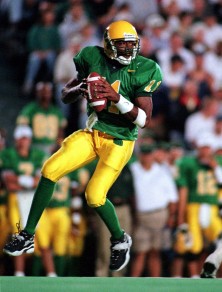 The quarterback quandary was certainly on in Eugene. In the spring, no battle was more anticipated or scrutinized than the quarterback. The expectations were set to dizzying heights for whoever won the starting position, tasked with becoming the new quarterback at Oregon–a position that with the previous four starters had led Oregon’s rise to power, from doormat to Pac-10 champion. Chris Miller, Bill Musgrave, Danny O’Neil, and Tony Graziani ranked as the four best single-season performers on the school’s all-time ledger, the prior four quarterbacks in a row all raising expectations to perhaps unrealistic standards given the lack of extended playing time for Maas, and the potential not yet realized in Smith; much like the daily Bennett vs. Mariota battle being fought today.
The quarterback quandary was certainly on in Eugene. In the spring, no battle was more anticipated or scrutinized than the quarterback. The expectations were set to dizzying heights for whoever won the starting position, tasked with becoming the new quarterback at Oregon–a position that with the previous four starters had led Oregon’s rise to power, from doormat to Pac-10 champion. Chris Miller, Bill Musgrave, Danny O’Neil, and Tony Graziani ranked as the four best single-season performers on the school’s all-time ledger, the prior four quarterbacks in a row all raising expectations to perhaps unrealistic standards given the lack of extended playing time for Maas, and the potential not yet realized in Smith; much like the daily Bennett vs. Mariota battle being fought today.
As fall camp played out, both quarterbacks received rave reviews, neither separating from the other. One day Maas would get the better of it, the next Smithwas the one who shined. September came, and Coach Mike Bellotti had yet to announce a starter for the rare Thursday night conference opener versus Arizona on September 4. It was such a close and tight battle, it would be a game-time decision for Bellotti.
After deliberation it was decided–both performed so well in camp, both deserved to play. Rather than naming one outright starter, there would be a rotation at the position. Considering the positive reviews of both Bennett and Mariota, this remains a viable option for the 2012 season as well.
Marco Aguirre and the O-Line
The great subtext behind the quarterback battle getting all the press remained whom exactly would block for them, and returning starting runningback Saladin McCullough. Marco Aguirre came aboard with expectations of filling a role immediately a junior college transfer from Mount San Antonio College, in Walnut, California.
“I arrived in the winter term (January, 1997) to get established,” Aguirre recalls. “After the Christmas break, I came up, but I guess it was a day too early because when I got there, they were still closed and no one was there. I had to sleep in my car the first night, because there was no one at the dorm and they couldn’t let me in.”
For Aguirre, the prospect of getting a legitimate shot to play immediately was too enticing to pass up compared the other schools courting the talented lineman. “The only other schools I was looking at were UCLA and Washington State. I toured Wisconsin, but it was small compared to everyone else; it wasn’t the right school for me. UCLA, I didn’t feel the line coach was on the same page. Washington State was too far in the middle of nowhere. Eugene was real nice. It was nice knowing I would play and be a starter, and to find the same offense I was used to helped to understand and get everything quickly.”
Aguirre didn’t have to wait long to see the field, coming straight from the JC ranks into a starting role that he would retain for the next two seasons.
“I had an advantage being there for winter term. I had played in the spring game and got established. There were a lot of new kids that had to come in for fall camp and during September during the fall; but I was already there. Since January, I had worked to learn everything, train, and be prepared for fall camp. Also, Mount San Antonio ran a very similar offense I was already acclimated to. I had an advantage on that end.”
Given the lack of experience in the remaining offensive linemen in Oregon’s system, the lone veteran on the squad was relied on heavily to relay information to the newcomers.
“The main guy that year was (David) Weber. He was the one who taught everyone, because he was the only starter from the year before. He and (previous backup) Seaton Daly were the seniors of that year. They had been around and seen all, I was the new one. If you had any questions, you just asked Weber, because he was the smartest one there and knew the most. Daly was the one who took over after Weber got injured. It was fun; but also hard. We were all learning at the same time, especially me coming in.”
Weber’s lessons paid off well, as Oregon’s offensive line played admirably with their patchwork lineup. 1997 would prove to be a year of experimentation, treated almost like a precursor to the success of the 1998 season. The Ducks rotated both Maas and Smith at quarterback extensively, awaiting for one to emerge. By the end of the year, that was Akili Smith, ready to take the reigns in 1998, setting nearly every single-season passing record at Oregon and earning his status as the third overall draft pick in the 1999 NFL draft.
The experimentation continued along the offensive line, using plug-and-play linemen such as Aguirre to gain experience for what became a potent offense in 1998, for the first half of the year the #1 offense in the country averaging 50 points a game. Damon Griffin, who could have returned halfway through the 1997 season from his thumb injury, instead chose to redshirt the season to return for his senior year knowing that the 1998 would be special–Griffin became a 1st team All-Pac-10 selection the next year. The uncertainty of 1997 gave way to the excellence of 1998, Oregon appearing to be unstoppable, until injuries would derail the efforts, forever leaving fans to wonder how good the 1998 team had been if key players had not been struck down mid-season.
Aguirre recalls the ongoing experimentation with lineups to find what worked best. “It was a rough start. We weren’t fully prepared by game time. When I think back to the Arizona game to open the season, it was rough. I think against Nevada (in the second game) that one really helped us out a lot. That was a real turning point of that year. It was really close. It was a pretty tough game. On one drive, we started out at the one yard-line, and had a 99 yard drive. It was pretty tough, but I think that game helped us out and started the come-together process.”
The Ducks would finish 1997 at 6-5, swapping Maas and Smith between drives and mixing-and-matching lineman in a season-long trial and error process to see what might work. BY the end of the year they had it down, and knew that through the year-long process they were going to have a special team returning the next year. Oregon would dominate Air Force in the Las Vegas Bowl, scoring long touchdowns on the first two plays from scrimmage on their way to a 41-13 victory.
The lessons to be learned from the past can be used to foresee the future. Oregon has been a great team the past few years, and with the returning talent they can potentially be great again.
However with expectations sky high for this team, some reality needs to be maintained, that with Oregon having to replace statistically the greatest running back and quarterback tandem in school history with talented but inexperienced players, there is the potential for a repeat of a 1997-style season–A year where players are mixed-and-matched, various lineups are tested to see what works, quarterbacks are rotated each given an opportunity to see who can best lead, and the final results immediately may not be completely to Oregon fan’s liking, but has the potential to pay even bigger dividends down the road.
By the end of the season, Oregon’s offensive line was opening up huge gaps
Related Articles:
These are articles where the writer left and for some reason did not want his/her name on it any longer or went sideways of our rules–so we assigned it to “staff.” We are grateful to all the writers who contributed to the site through these articles.

